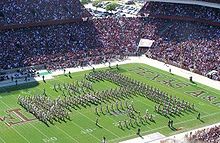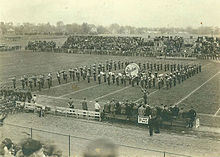Instrumentation
The size and composition of a marching band can vary greatly. Some bands have fewer than twenty members, and some have over 500. American marching bands vary considerably in their instrumentation. Some bands omit some or all woodwinds, but it is not uncommon to see piccolos, flutes, soprano clarinets, alto saxophones, and tenor saxophones. E♭ clarinets, alto clarinets, bass clarinets, and baritone saxophones are less common, but can be found in some bands. Bassoons and oboes are very seldom found on a field due to the risk of incidental damage, the impracticality of marching with an exposed double reed, and high sensitivity to weather.The brass section usually includes trumpets or cornets, French horns, alto horns, or mellophones, tenor trombones, baritone horns or euphoniums, and tubas or sousaphones. E♭soprano cornets are sometimes used to supplement or replace the high woodwinds. Some especially large bands use flugelhorns and bass trombones. Specially designed versions of the lower brass have been created for use while marching. These are typically wrapped in such a way that allow the bell to face toward the audience at all times. Bands may also modify their instrumentation to remove slide trombones completely and replace them with another instrument, such as a valved trombone or marching baritone horn.
Marching percussion (often referred to as the drumline, battery, or back battery) typically includes snare drums, tenor drums, bass drums, and cymbals and are responsible for keeping tempo for the band. All of these instruments have been adapted for mobile, outdoor use. Marching versions of the glockenspiel (bells), xylophone, and marimba are also rarely used by some ensembles. Historically, the percussion section also employed mounted timpani that featured manual controls.
For bands that include a front ensemble (also known as the pit or auxiliary percussion), stationary instrumentation may include orchestral percussion such as timpani, tambourines, maracas, cowbells, congas, wood blocks, marimbas, xylophones, bongos, vibraphones, timbales, claves, guiros, and chimes or tubular bells, concert bass drums, and gongs, as well as a multitude of auxiliary percussion equipment. Drum sets, purpose-built drum racks, and other mounted instruments are also placed here. Until the advent of the pit in the early 1980s, many of these instruments were actually carried on the field by marching percussionists by hand or on mounting brackets. Some bands also include electronic instruments such as synthesizers, electric guitars, and bass guitar, along with the requisite amplification. If double-reed or string instruments are used, they are usually placed here, but even this usage is very rare due to their relative fragility. Unusual percussive instruments are sometimes used, including brake drums, empty propane tanks, trashcans, railroad ties, stomping rigs, and other interesting sounds.
A rare inclusion in a marching band that is becoming more popular is the use of Electrophones in a marching band. The most common electric instrument seen is a bass guitar, but some schools also use keyboards and lead guitar. To make the electric instruments usable, external power in the stadium is normally used, but some groups may use a car-battery mechanism that requires a car battery and a converter to give the instruments and amplifiers remote power. Most bands will have the guitars in the pit with keyboard and auxiliary percussion, but some guitarists do march in the field show. This is made possible by the use of wireless transmission systems that allow the guitarists to hook a wireless transmitter to their instrument, while a receiver is hooked to the amp. This allows free motion of the guitarists to a fixed range of distance between the transmitter and receiver. This implementation of equipment can also be used in parades. Some band scores have parts for bass guitar, but in the event that a score does not, the bass guitarist will normally play tuba/sousaphone, bassoon, baritone-bass clef, euphonium-bass clef, or trombone music. It is very rare for a score to have a part for electric guitar, but the guitarist may use oboe or flute music in this situation.
Auxiliary
Many bands have auxiliaries that add a visual component to the performance. For ceremonial bands, this could be a traditional color guard or honor guard. For drum & bugle corps and corps-style field bands, this could include Dance lines, majorettes, Auxiliary units may be collectively referred to as color guard or visual ensemble.Auxiliaries may perform as independent groups. In the early 1970s, color guards began to hold their own competitions in the winter (after the American football season, and before the beginning of the summer drum and bugle corps season). These became known as winter guard. There are also numerous dance competitions in the off-season.
The color guard of a marching band or drum and bugle corps may contain sabers, mock rifles, and tall flags. In modern bands, other props are often used: flags of all sizes, horizontal banners, vertical banners, streamers, pom-poms, even tires, balls, and hula hoops or custom built props. The color guard may also employ stage dressing such as backdrops, portable flats, or other structures. These can be used simply as static scenery or moved to emphasize block drill, and are often used to create a "backstage" area to store equipment and hide personnel.
While military color guards were typically male, band color guards tend to be primarily female, though it is becoming more common for men to join as well. A few independent units are all-male. Guard members nearly always wear a special uniform or costume that is distinctive from that of the band, not necessarily matching in design or color. The men's and women's guard uniforms are usually designed in one of two ways: nearly identically, but with gender-specific parts (i.e. skirts) adapted for the use of the opposite sex; or complimentarily, with the two uniforms designed similarly but with variations in color or form. The color guard uniform, especially in a high school marching band, need not be in school colors; in fact, they rarely are. These uniforms are designed to represent a certain aspect of the halftime show, characterize the guard members through costumization, or tell some sort of story, and can thus be in any design or color (a surprisingly common complaint among the high school audience is that guard uniforms and equipment "aren't school colors").
Personnel

The Pride of the Sunshine the marching band which represents the University of Florida during athletic events
The size of the band may not only determine how many drum majors there are, but how many section instructors are needed as well. Section instructors function like the music director, but are mainly responsible for teaching members of a given section. Because they are commonly previous members of the section they teach, they're able to provide better instruction to combine the needs of the show with the characteristics of the given instrument.
As bands require leadership from within as well as from without, section leaders will usually be selected from among the members of each instrumental section (a "section" comprises all the band members who play the same musical instrument). The section leader is always an experienced band member, and is usually selected by the band director (rather than elected or self-appointed) for his or her leadership skills and experience. The section leader is responsible for the minute-to-minute instruction of his or her section members, and reports to the drum majors and the band director.
The director provides general guidance, selects the repertoire, interprets commentary and evaluations from judges, and auditions and/or recruits prospective members. What content is not provided by the director may be contracted from arrangers (who compose original works or adapt existing works) and copyists (who reproduce the parts of the score), choreographers, and drill designers (primarily for field bands). With the assistance of section instructors, the director also teaches performance technique—musical, martial, and visual—and assesses the pool of talent, choosing leaders and soloists as needed. The director also selects venues for public performance and oversees the staff that help provide funding and equipment. Many opportunities for member improvement are present: the director may organize clinics with various professionals, send representatives to specialty schools or camps, and/or plan trips abroad for education or exhibition.
Large bands also require a number of support staff who can move equipment, repair instruments and uniforms, create and manipulate props used in performances, and provide food, water and medical assistance. Additional staff may be utilized when the band hosts functions such as competitions and reviews. In high school bands, these activities are usually performed by volunteers, typically parents of band members or the band members of the lower grades. These people are often referred to as "runners" or "boosters". Significant support staff for college bands and independent corps are typically paid by the university or the corps organization, respectively.




